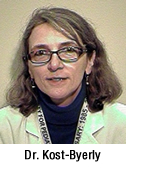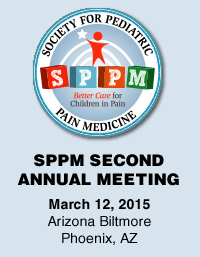president's message
SPPM First Annual Meeting and Future Frontiers
 By Sabine Kost-Byerly, MD
By Sabine Kost-Byerly, MD
The Johns Hopkins Hospital
Baltimore, MD
After a never-ending winter many of us were all too happy to escape to warm and sunny Fort Lauderdale for the Society’s First Annual Meeting. Just seeing blue skies, sand, and palm trees was balm for the souls of all of us who had faced snowdrifts and icy roads on their way to work for so many days. We had great speakers, thought-provoking presentations, and best of all, a wonderful get-together of friends.
One of the presentations especially left an impression on me. Maria Fitzgerald, our keynote speaker from London, reviewed one of her experiments assessing pain in infants. Infants undergoing heel-lancing procedures for blood drawing were consoled with oral glucose while behavioral pain scores and simultaneous EEG recordings provided a picture of the child’s pain experience. Interestingly, in contrast to the behavioral pain score suggesting that the child was indeed receiving some form of analgesia from the oral glucose, the EEG showed brain activation patterns consistent with continued pain.
This finding was disconcerting to me for more than one reason: how much can I really rely on my pain assessment tools and why had I not heard of this study before?
Are infants at risk for long-term, pain-associated changes of the central nervous system while they seemingly look content with low behavioral pain scores during procedures? While Maria explained these observations in her fabulous way of making difficult science look easy, I was wondering what else I may be taking for granted as a well-established standard of care but which may only be one piece of the puzzle in the human pain experience.
My unawareness of this research was ultimately not too surprising. The medical literature can be overwhelming, even in sub-subspecialty fields. For the busy practitioner it is nearly impossible to stay informed of all new and important developments. If you were not able to attend the meeting you can explore Mariah and her team’s research: Oral sucrose as an analgesic drug for procedural pain in newborn infants: a randomized controlled trial. (Lancet 2010; 376: 1225-32). I also suggest reading the letters to the editor following the publication and the authors’ response. Clearly, I was not the only one unnerved by the findings.
I sincerely hope that you had similar enlightening experiences at the First Annual Meeting. The Society for Pediatric Pain Medicine wants to continue to offer meetings that challenge current practice, present new scientific evidence, engage its members, and ultimately improve pediatric pain management. Preparations for our Second Annual Meeting at the historic Arizona Biltmore Resort in Phoenix are already in progress. I hope I can welcome many of your there on March 12, 2015.
Now, to what is new for the Society this summer - Elections!!
I will continue to serve as President of the Society for two years and then move on to Immediate Past President for an additional two years.
Members of the Society will elect a Vice President/President-elect who will automatically become President in two years and a Secretary-Treasurer, who could ascend to President-elect if nominated in two years on the next slate. The Secretary-Treasurer may ascend to President-Elect but this will not be an automatic move. While continuity and seamless involvement assures awareness and familiarity with the needs of the Society and its membership, the associated obligation to serve on the Board for multiple years may be more than an individual can agree to.
The Directors-at-Large will be elected to serve single four-year terms, except that we need to stagger their terms so that every two years only half will rotate off. We believe the best way to accomplish this is to initially assign the term lengths based on number of votes. In other words, four at-large directors will serve four-year terms, and the other four will serve two years and then be eligible for a full four-year term (if elected). Those who begin service as a Director-at-Large and then move into the officer track are looking at a serious commitment of up to 12-14 years.
SPPM members may self nominate or nominate a fellow SPPM member. All nominees must be SPPM members and be available to attend two in-person SPPM board meetings each year, including the meeting scheduled for Saturday, October 11, 2014, 1-4pm in New Orleans, LA, as well as additional teleconference meetings as necessary.
Nominees will also be required to submit a bio legend and headshot photo before the nomination deadline on August 15, 2014.

